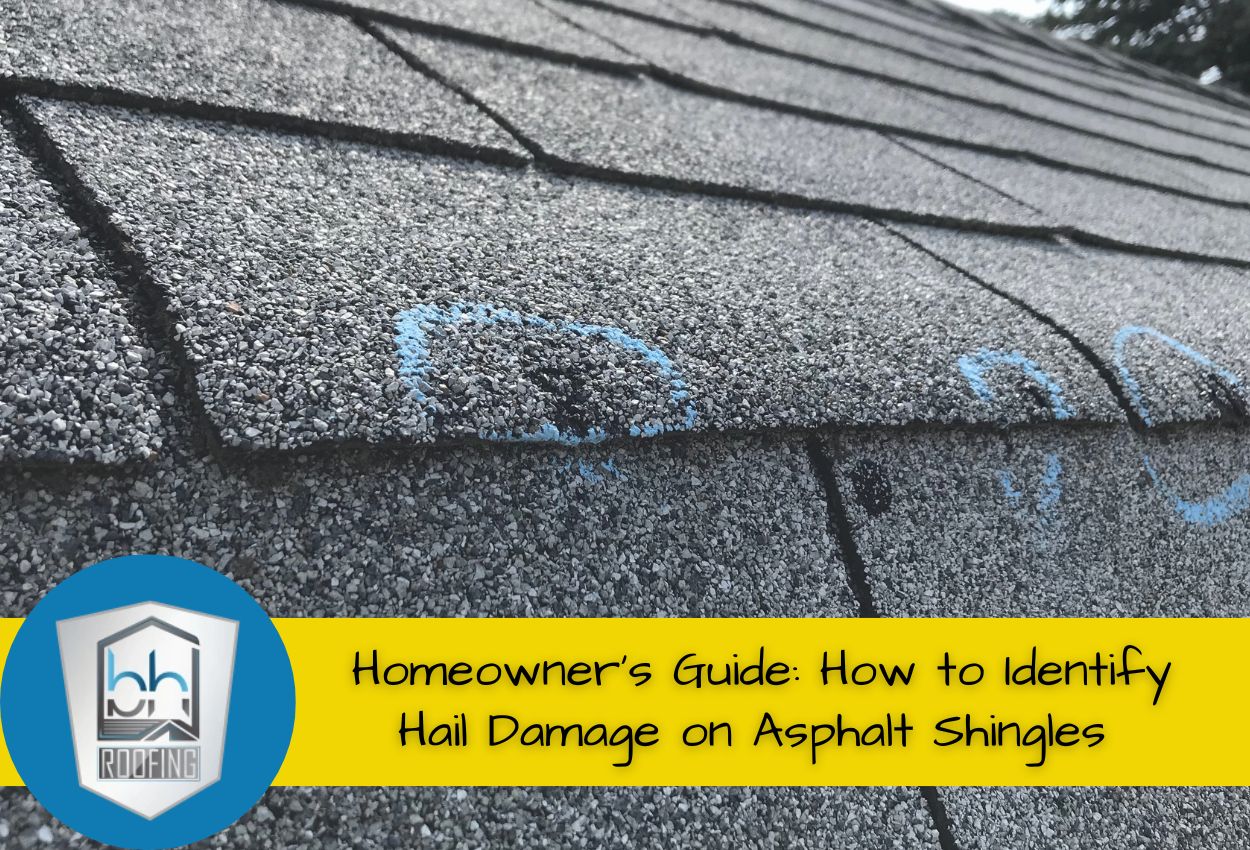San Antonio homeowners face severe weather throughout the year, with hailstorms ranking among the most damaging to residential roofs. Identifying hail damage on asphalt shingles quickly after a storm can prevent water infiltration issues and preserve your home’s structural integrity. Acting promptly also maximizes your potential insurance coverage, as many policies have time limitations for filing storm damage claims.
Hail impact on roof shingles creates distinctive patterns and damage signs that differ from normal weathering or aging. The key indicators include granule loss, random impact marks, and compromised shingle integrity — all of which require specific knowledge to properly recognize. Many homeowners miss these subtle signs until interior leaks appear, which typically indicates advanced damage requiring extensive repairs.
A roof inspection after a hailstorm requires both safety awareness and technical knowledge. Understanding what to look for helps San Antonio homeowners accurately diagnose hail-damaged roof shingles before secondary damage occurs. This guide walks through the identification process, safety considerations, and documentation steps essential for both roof protection and insurance purposes. Learning to recognize hail damage patterns on asphalt shingles allows homeowners to make better decisions about their roofing needs.
Understanding Hail Damage: What Happens When Hail Strikes Your Roof
When hail strikes your asphalt shingle roof in San Antonio, it creates a distinctive pattern of damage that varies based on hail size and storm intensity. Smaller hailstones (under 1 inch) typically cause granule displacement, where the protective mineral coating is knocked loose from shingles. During severe Texas storms, larger hailstones exceeding 1 inch can create immediate fractures, bruising, or even puncture the shingle material completely.
Fresh hail damage on asphalt shingles appears as random, circular impacts with a shiny center where granules have been freshly dislodged. These damaged areas feel soft when gentle pressure is applied, similar to a bruise. The exposed asphalt beneath appears darker and more reflective than the surrounding areas. These fresh impact marks have clean, defined edges that haven’t yet weathered.
In contrast, older hail damage shows oxidation around impact sites, appearing more weathered with less defined boundaries. The exposed asphalt darkens further and may develop small cracks extending from impact centers. Signs of asphalt shingle granule loss from hail can be found in gutters and downspouts after recent storms, providing additional confirmation of roof damage. Understanding these visual indicators helps homeowners recognize when a professional roof inspection after a hailstorm is necessary.
Key Visual Indicators of Hail-Damaged Shingles
Recognizing hail damage on asphalt shingles requires looking for specific visual cues that distinguish storm impact from normal wear. The most telling sign is the presence of circular or pock-marked indentations randomly distributed across your roof. These impact marks typically measure between 1/2 inch to 2 inches in diameter, depending on the hailstone size that struck San Antonio during the storm. As mentioned above, fresh hail impacts appear as dark spots where the protective granule layer has been forcibly removed, exposing the black asphalt mat underneath.
Another key indicator is bruising, where the shingle feels soft and spongy when gently pressed. This occurs when hail impacts create fractures beneath the surface while the top remains visually intact. Look also for splatter marks — small black spots where hailstones have shattered on impact, displacing granules in a distinctive pattern. These signs of hail impact on roof shingles differ from manufacturing defects, which typically appear in straight lines or regular patterns across multiple shingles.
Unlike normal aging, which causes uniform granule loss and weathering across the entire roof surface, hail damage patterns on roofs appear as random, concentrated areas of damage. San Antonio roofing professionals recommend examining areas around roof vents, gutters, and metal flashing for denting, as these metal components show hail impacts more clearly and can confirm whether your asphalt shingles have also sustained damage.
Granule Loss: A Critical Sign of Hail Impact
Excessive granule loss represents one of the most reliable indicators when diagnosing hail-damaged roof shingles. After a hailstorm passes through San Antonio, inspect your gutters, downspouts, and the ground around your home for unusual accumulations of granules. While all asphalt shingles naturally shed some granules over time, hail damage causes concentrated, excessive shedding in specific areas that correspond with impact zones. These dislodged granules appear as small, colored grit that matches your shingle color.
To properly assess whether granule loss indicates hail damage rather than normal aging, examine the pattern of the exposed asphalt underneath. Hail-induced granule loss creates distinct circular or pock-marked patterns where the black asphalt layer becomes visible. These exposed areas will have sharply defined edges and often feel slightly softer to the touch than the surrounding material. In contrast, age-related granule loss typically presents as uniform thinning across entire shingle sections rather than concentrated spots.
Texas storms frequently produce conditions where multiple hailstones strike the same area, creating a cluster effect of granule loss. This concentrated damage accelerates roof deterioration as the exposed asphalt quickly deteriorates under the harsh San Antonio sun. When examining your roof after a storm, pay particular attention to areas where granule loss reveals a shiny or reflective asphalt surface — this indicates recent impact rather than long-term weathering, which would appear more dull and oxidized.
Inspecting Your Roof Safely After a San Antonio Hailstorm
After a severe hailstorm passes through San Antonio, the natural impulse is to immediately check your roof for damage. However, safety must remain your top priority during this assessment. The safest initial inspection method is to remain firmly on the ground, using binoculars to scan your roof. Early morning or late afternoon provides optimal lighting conditions, as the angled sunlight helps highlight dents and depressions that might otherwise go unnoticed during midday inspections.
When conducting ground-level roof inspections, focus first on easily visible areas like the edges and lower sections. Look for obvious signs of granule accumulation in gutters or around downspouts, as this indicates potential shingle damage above. Photograph any visible damage using your phone or a camera to document potential issues clearly for insurance purposes.
Importantly, never attempt to climb onto your roof if it’s steep, typically any pitch greater than 6/12, wet, damaged, or if you lack proper safety equipment. San Antonio roofing contractors have the training and equipment to safely navigate these hazardous conditions. Professional roofers utilize fall protection systems, wear non-slip footwear, and have experience identifying subtle hail damage patterns that untrained observers might miss. When severe weather has impacted your neighborhood, scheduling a professional roof inspection ensures both your personal safety and a thorough assessment of any damage.
Documenting Hail Damage for Insurance Claims
Documenting hail damage is essential for successfully navigating the insurance claim process after a severe storm hits your San Antonio home. Begin by taking clear, high-resolution photographs of all damaged areas, including wide shots of the entire roof and closer shots of individual damaged shingles. Use a ruler or coin in these close-up images to provide scale reference for the insurance adjuster. Capture images of any displaced granules in gutters or around downspouts, as this provides compelling evidence of recent impact damage.
Maintain a detailed record of when the hailstorm occurred, including the approximate time, duration, and estimated hail size. Local weather reports and alerts on your phone can serve as verification of the storm’s severity. Create a written inventory listing all damaged areas, noting their location on the roof and the specific type of damage observed, whether granule loss, cracks, or bruising. This documentation should be compiled promptly, as fresh hail damage shows more distinctive signs that may weather and become less obvious over time.
Many Texas insurance policies require claims to be filed within a specific timeframe after the damaging event. Contact your insurance company immediately after documenting the damage to initiate the claim process. Consider requesting a professional roof inspection from a reputable San Antonio roofing contractor who can provide a detailed damage assessment report with supporting photographs. This third-party verification often strengthens insurance claims by providing expert testimony about the signs of hail impact on roof shingles and distinguishing them from normal wear patterns.
Next Steps: Professional Assessment and Repair Options
After identifying potential hail damage on your asphalt shingles, the next critical step is a professional evaluation. Professional roof inspections in San Antonio typically include a comprehensive assessment where contractors examine not just the visible shingle damage but also check for compromised structural integrity beneath the surface. During this inspection, experienced roofers will systematically evaluate your entire roof system, including ridges, valleys, flashing, and ventilation components that may have sustained hail impact but show less obvious signs of damage.
Professional roofers follow a specific approach to diagnosing hail-damaged roof shingles, marking damaged areas with chalk and documenting findings with photographs. They’ll assess damage severity, distinguishing between cosmetic issues and functional damage that compromises your roof’s weather resistance. Most San Antonio contractors will provide a detailed written report outlining their findings, recommended repair options, and an explanation of how these damages might progress if left unaddressed.
The appropriate repair strategy depends entirely on the extent of the damage. Minor hail impact with limited granule loss might require spot repairs to individual shingles, while moderate to severe damage often necessitates partial or complete roof replacement. When selecting a roofing contractor, prioritize companies with specific experience recognizing hail damage patterns on roofing materials, valid licenses, insurance, and local references.
Hail Damage Roof Repair in San Antonio with BH Roofing
If you’ve identified signs of hail damage on your asphalt shingles, it’s crucial to act swiftly to prevent further damage to your property. BH Roofing specializes in diagnosing and repairing hail-damaged roofs, keeping your home safe and secure. Whether it’s granule loss, bruising, or visible indentations, our expert team is equipped to handle all levels of hail damage repair.
Contact BH Roofing today at (210) 267-9029 for a professional hail damage roof inspection. Ensure your roof is in top condition with our trusted local experts in San Antonio.


